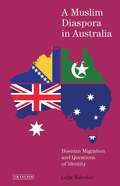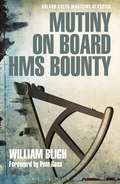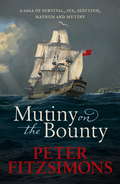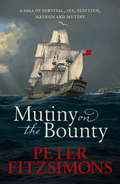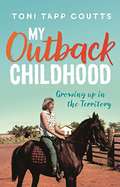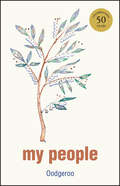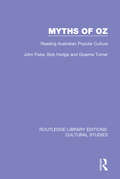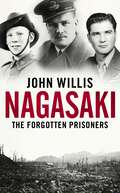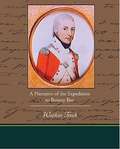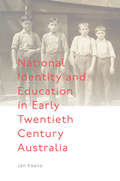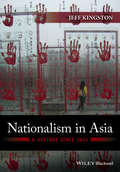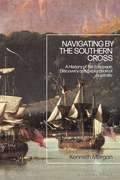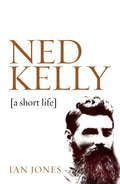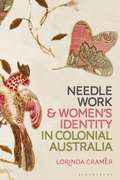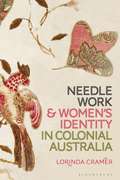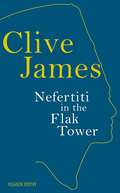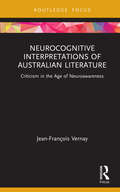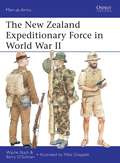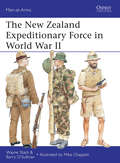- Table View
- List View
A Muslim Diaspora in Australia: Bosnian Migration and Questions of Identity
by Lejla VoloderIn a world of increasingly mixed identities, what does it mean to belong? As western democracies increasingly curtail their support for multiculturalism, how can migrants establish belonging as citizens? A Muslim Diaspora in Australia explores how a particular migrant group has faced the challenges of belonging. The author illustrates how Bosnian migrants in Australia have sought to find places for themselves as migrants, as refugees, and as Muslims, in Australia and Australian society. Challenging the methodological nationalism that tends to dominate discussions of migrant identities, the author exposes the ways in which dignity emerges as a dominant concern for people as they relate to varied local, national and translational contexts. Very little is known about how migrants themselves read and react to the multiple challenges of belonging and this pioneering work offers a timely and much needed critical insight into what it means to belong.
Mutiny On Board HMS Bounty (Great Illustrated Classics #Vol. 19)
by William BlighOn 28th April 1789 a small and unremarkable merchant vessel became one of the most famous ships in maritime history. HMS Bounty was under the command of 34-year-old Lieutenant William Bligh, an inexperienced commander who lacked the respect of a crew attracted to the promise of an easy life in a Tahitian paradise.Fletcher Christian led half the crew in mutiny against Bligh and after overpowering all resistance, they cast their deposed captain adrift along with those still loyal to him. Luckily for Bligh, his skills as a navigator were better than his skills as a captain and he managed to sail the 23ft boat 3,618 nautical miles to Timor in the Dutch East Indies with no chart or compass, and only a quadrant and a pocket watch for navigation. On returning to England he reported what had happened, and the Royal Navy hunted down and captured most of the mutineers.However, this is only half the story – William Bligh's version. The captured mutineers went on trial and their testimonies give a much less heroic portrait of their former captain, accusing him of unduly harsh treatment. Fletcher Christian's older brother Edward, a judge, oversaw a more balanced account of the mutiny. Of the mutineers who returned to England, only three were hanged; four were acquitted and three pardoned.This book gives the fullest version of the mutiny, allowing Bligh's account to sit alongside those of his detractors. The discrepancies are fascinating, and allow us to make up our own minds about this infamous mutiny.Also includes an exclusive Foreword by former World Sailor of the Year Pete Goss, who offers a unique perspective on the trials and tribulations of the Bounty's crew, whether castaway or mutineer.
Mutiny on the Bounty: A saga of sex, sedition, mayhem and mutiny, and survival against extraordinary odds
by Peter FitzSimonsThe mutiny on HMS Bounty, in the South Pacific on 28 April 1789, is one of history's truly great stories - a tale of human drama, intrigue and adventure of the highest order - and in the hands of Peter FitzSimons it comes to life as never before.Commissioned by the Royal Navy to collect breadfruit plants from Tahiti and take them to the West Indies, the Bounty's crew found themselves in a tropical paradise. Five months later, they did not want to leave. Under the leadership of Fletcher Christian most of the crew mutinied soon after sailing from Tahiti, setting Captain William Bligh and 18 loyal crewmen adrift in a small open boat. In one of history's great feats of seamanship, Bligh navigated this tiny vessel for 3618 nautical miles to Timor.Fletcher Christian and the mutineers sailed back to Tahiti, where most remained and were later tried for mutiny. But Christian, along with eight fellow mutineers and some Tahitian men and women, sailed off into the unknown, eventually discovering the isolated Pitcairn Island - at the time not even marked on British maps - and settling there.This astonishing story is historical adventure at its very best, encompassing the mutiny, Bligh's monumental achievement in navigating to safety, and Fletcher Christian and the mutineers' own epic journey from the sensual paradise of Tahiti to the outpost of Pitcairn Island. The mutineers' descendants live on Pitcairn to this day, amid swirling stories and rumours of past sexual transgressions and present-day repercussions. Mutiny on the Bounty is a sprawling, dramatic tale of intrigue, bravery and sheer boldness, told with the accuracy of historical detail and total command of story that are Peter FitzSimons' trademarks.
Mutiny on the Bounty: A saga of sex, sedition, mayhem and mutiny, and survival against extraordinary odds
by Peter FitzSimonsThe mutiny on HMS Bounty, in the South Pacific on 28 April 1789, is one of history's great epics - and in the hands of Peter FitzSimons it comes to life as never before.Commissioned by the Royal Navy to collect breadfruit plants from Tahiti and take them to the West Indies, the Bounty's crew found themselves in a tropical paradise. Five months later, they did not want to leave. Under the leadership of Fletcher Christian most of the crew mutinied soon after sailing from Tahiti, setting Captain William Bligh and 18 loyal crewmen adrift in a small open boat. In one of history's great feats of seamanship, Bligh navigated this tiny vessel for 3618 nautical miles to Timor.Fletcher Christian and the mutineers sailed back to Tahiti, where most remained and were later tried for mutiny. But Christian, along with eight fellow mutineers and some Tahitian men and women, sailed off into the unknown, eventually discovering the isolated Pitcairn Island - at the time not even marked on British maps - and settling there.This astonishing story is historical adventure at its very best, encompassing the mutiny, Bligh's monumental achievement in navigating to safety, and Fletcher Christian and the mutineers' own epic journey from the sensual paradise of Tahiti to the outpost of Pitcairn Island. The mutineers' descendants live on Pitcairn to this day, amid swirling stories and rumours of past sexual transgressions and present-day repercussions. Mutiny on the Bounty is a sprawling, dramatic tale of intrigue, bravery and sheer boldness, told with the accuracy of historical detail and total command of story that are Peter FitzSimons' trademarks.
My Outback Childhood (younger readers): Growing up in the Territory
by Ms Toni Tapp CouttsThere was something interesting around every corner, be it brumbies and wild donkeys disappearing through the bush, or a little waterhole where the snakes and kangaroos came to drink.Toni's childhood isn't like other kids'. She is only five years old when her mum packs a small suitcase and takes the family over 300 kilometres on a scratchy dirt track to live at Killarney, a remote cattle station in the Northern Territory. Toni grows up among the cattle and horses, with the wild Territory climate and even wilder native animals around her. She has adventures with Old Dora and Daisy, the Aboriginal women who help raise her and her brothers and sisters. They teach her about bush tucker and tell her stories of debil debils.My Outback Childhood is the story of Toni's unconventional upbringing on Killarney - stalking goannas, helping in the cattle yards, riding horses and sleeping under the stars. Young readers will be captivated by this true story of a childhood filled with Outback adventures. Fascinating for city kids and country children alike, this is a unique story that educates as well as entertains.
My People
by Noonuccal OodgerooImmerse yourself in the poetry of one of Australia’s foremost Indigenous artists My People is a compilation of the poetry of Oodgeroo, of the tribe Noonuccal, Custodian of the land Minjerribah. This collection of captivating poetry detailing the struggle of Australia’s Indigenous peoples is more relevant today than ever before. While she passed away in 1993, Oodgeroo remains one of Australia’s most influential Aboriginal poets. Her poetry leaves little room to argue why that shouldn’t be the case. Razor-sharp and incisive, while simultaneously haunting and beautiful, Oodgeroo’s poems will enchant both young and old alike. My People is a bewitching collection of Oodgeroo’s poems that belongs on the bookshelves of every art lover and anyone with an appreciation of the written word.
My People
by Noonuccal OodgerooImmerse yourself in the poetry of one of Australia’s foremost Indigenous artists My People is a compilation of the poetry of Oodgeroo, of the tribe Noonuccal, Custodian of the land Minjerribah. This collection of captivating poetry detailing the struggle of Australia’s Indigenous peoples is more relevant today than ever before. While she passed away in 1993, Oodgeroo remains one of Australia’s most influential Aboriginal poets. Her poetry leaves little room to argue why that shouldn’t be the case. Razor-sharp and incisive, while simultaneously haunting and beautiful, Oodgeroo’s poems will enchant both young and old alike. My People is a bewitching collection of Oodgeroo’s poems that belongs on the bookshelves of every art lover and anyone with an appreciation of the written word.
Myths of Oz: Reading Australian Popular Culture (Routledge Library Editions: Cultural Studies)
by John Fiske Bob Hodge Graeme TurnerThis book, first published in 1987, sets out to examine and extend our understanding of Australian popular culture, and to counter the long-established, traditional criticism bewailing its lack. The authors argue that the 'knocker's' view started from an elitist viewpoint, yearning for Australia to aspire to a European culture in art, music, literature and other traditional cultural fields. They argue however that there are other definitions of culture that are more populist, more comprehensive, and which represent a vitality and dynamism which is a true reflection of the lives and aspirations of Australians. Myths of Oz offers no comprehensive definition of Australian culture, but rather a way of interpreting its various aspects. The barbeque or the pub, an expedition to the shops or a day at the beach, the home, the workplace or the job queue; all these intrinsic parts of Australian life are examined and conclusions drawn as to how they shape or are shaped by what we call popular culture. The authors look too at monuments and symbols, from Ayers Rock to the Sydney Opera House, which both shape and reflect Australian culture, while a chapter on the Australian accent shows how language and terminology play a powerful role in establishing cultural standpoints. A particular strength of this book is that while delivering a provocative and stimulating series of viewpoints on popular culture, it also makes use of current academic tools and methodology to ensure that we gain new insights into the meanings and pleasures we derive from our everyday experiences.
Myths of Oz: Reading Australian Popular Culture (Routledge Library Editions: Cultural Studies)
by John Fiske Bob Hodge Graeme TurnerThis book, first published in 1987, sets out to examine and extend our understanding of Australian popular culture, and to counter the long-established, traditional criticism bewailing its lack. The authors argue that the 'knocker's' view started from an elitist viewpoint, yearning for Australia to aspire to a European culture in art, music, literature and other traditional cultural fields. They argue however that there are other definitions of culture that are more populist, more comprehensive, and which represent a vitality and dynamism which is a true reflection of the lives and aspirations of Australians. Myths of Oz offers no comprehensive definition of Australian culture, but rather a way of interpreting its various aspects. The barbeque or the pub, an expedition to the shops or a day at the beach, the home, the workplace or the job queue; all these intrinsic parts of Australian life are examined and conclusions drawn as to how they shape or are shaped by what we call popular culture. The authors look too at monuments and symbols, from Ayers Rock to the Sydney Opera House, which both shape and reflect Australian culture, while a chapter on the Australian accent shows how language and terminology play a powerful role in establishing cultural standpoints. A particular strength of this book is that while delivering a provocative and stimulating series of viewpoints on popular culture, it also makes use of current academic tools and methodology to ensure that we gain new insights into the meanings and pleasures we derive from our everyday experiences.
Nagasaki: The Forgotten Prisoners
by John WillisThis is one of the most remarkable untold stories of the Second World war. At 11.02 am on an August morning in 1945 America dropped the world's most powerful atomic bomb on the Japanese port city of Nagasaki. The most European city in Japan was flattened to the ground 'as if it had been swept aside by a broom'. More than 70,000 Japanese were killed. At the time, hundreds of Allied prisoners of war were working close to the bomb's detonation point, as forced labourers in the shipyards and foundries of Nagasaki.These men, from the Dales of Yorkshire and the dusty outback of Australia, from the fields of Holland and the remote towns of Texas, had already endured an extraordinary lottery of life and death that had changed their lives forever. They had lived through nearly four years of malnutrition, disease, and brutality. Now their prison home was the target of America's second atomic bomb.In one of the greatest survival stories of the Second World War, we trace their astonishing experiences back to bloody battles in the Malayan jungle, before the dramatic fall of Fortress Singapore, the mighty symbol of the British Empire. This abject capitulation was followed by surrender in Java and elsewhere in the East, condemning the captives to years of cruel imprisonment by the Japanese. Their lives grew evermore perilous when thousands of prisoners were shipped off to build the infamous Thai-Burma Railway, including the Bridge on the River Kwai. If that was not harsh enough, POWs were then transported to Japan in the overcrowded holds of what were called hell ships. These rusty buckets were regularly sunk by Allied submarines, and thousands of prisoners lived through unimaginable horror, adrift on the ocean for days. Some still had to endure the final supreme test, the world's second atomic bomb.The prisoners in Nagasaki were eyewitnesses to one of the most significant events in modern history but writing notes or diaries in a Japanese prison camp was dangerous. To avoid detection, one Allied prisoner buried his notes in the grave of a fellow POW to be reclaimed after the war, another wrote his diary in Irish. Now, using unpublished and rarely seen notes, interviews, and memoirs, this unique book weaves together a powerful chorus of voices to paint a vivid picture of defeat, endurance, and survival against astonishing odds.
National Identity and Education in Early Twentieth Century Australia
by Jan KeaneThis fascinating book explores how curriculum content in education was used to cultivate a sense of Australian national identity during the first two decades of the twentieth century. Providing a comprehensive picture of the entire reading curriculum in Victorian government schools over a period of almost two decades, the author demonstrates that, contrary to received wisdom, the Department of Education made every effort to integrate children of different backgrounds. Using three dimensions frequently cited in national identity theory – landscape, history, and mythology – readers are shown how material was chosen specifically to engage young white settler children and to help them overcome their sense of Australia as the ‘other’. National Identity and Education in Early Twentieth Century Australia not only brings about a clearer understanding of how Australia came to be ‘Australian’ in character, it establishes how curriculum content may be brought into the service of nation-building across the globe.
National Identity and Education in Early Twentieth Century Australia
by Jan KeaneThis fascinating book explores how curriculum content in education was used to cultivate a sense of Australian national identity during the first two decades of the twentieth century. Providing a comprehensive picture of the entire reading curriculum in Victorian government schools over a period of almost two decades, the author demonstrates that, contrary to received wisdom, the Department of Education made every effort to integrate children of different backgrounds. Using three dimensions frequently cited in national identity theory – landscape, history, and mythology – readers are shown how material was chosen specifically to engage young white settler children and to help them overcome their sense of Australia as the ‘other’. National Identity and Education in Early Twentieth Century Australia not only brings about a clearer understanding of how Australia came to be ‘Australian’ in character, it establishes how curriculum content may be brought into the service of nation-building across the globe.
Nationalism in Asia: A History Since 1945
by Jeff KingstonUsing a comparative, interdisciplinary approach, Nationalism in Asia analyzes currents of nationalism in five contemporary Asian societies: China, India, Indonesia, Japan, and South Korea. Explores the ways in which nationalism is expressed, embraced, challenged, and resisted in contemporary China, India, Indonesia, Japan, and South Korea using a comparative, interdisciplinary approach Provides an important trans-national and trans-regional analysis by looking at five countries that span Northeast, Southeast, and South Asia Features comparative analysis of identity politics, democracy, economic policy, nation branding, sports, shared trauma, memory and culture wars, territorial disputes, national security and minorities Offers an accessible, thematic narrative written for non-specialists, including a detailed and up-to-date bibliography Gives readers an in-depth understanding of the ramifications of nationalism in these countries for the future of Asia
Nationalism in Asia: A History Since 1945
by Jeff KingstonUsing a comparative, interdisciplinary approach, Nationalism in Asia analyzes currents of nationalism in five contemporary Asian societies: China, India, Indonesia, Japan, and South Korea. Explores the ways in which nationalism is expressed, embraced, challenged, and resisted in contemporary China, India, Indonesia, Japan, and South Korea using a comparative, interdisciplinary approach Provides an important trans-national and trans-regional analysis by looking at five countries that span Northeast, Southeast, and South Asia Features comparative analysis of identity politics, democracy, economic policy, nation branding, sports, shared trauma, memory and culture wars, territorial disputes, national security and minorities Offers an accessible, thematic narrative written for non-specialists, including a detailed and up-to-date bibliography Gives readers an in-depth understanding of the ramifications of nationalism in these countries for the future of Asia
Navigating by the Southern Cross: A History of the European Discovery and Exploration of Australia
by Kenneth MorganIn this comprehensive study, Kenneth Morgan provides an authoritative account of European exploration and discovery in Australia. The book presents a detailed chronological overview of European interests in the Australian continent, from initial speculations about the 'Great Southern Land' to the major hydrographic expeditions of the 19th century. In particular, he analyses the early crossings of the Dutch in the 17th century, the exploits of English 'buccaneer adventurer' William Dampier, the famous voyages of James Cook and Matthew Flinders, and the little-known French annexation of Australia in 1772. Introducing new findings and drawing on the latest in historiographical research, this book situates developments in navigation, nautical astronomy and cartography within the broader contexts of imperial, colonial, and maritime history.
Navigating by the Southern Cross: A History of the European Discovery and Exploration of Australia
by Kenneth MorganIn this comprehensive study, Kenneth Morgan provides an authoritative account of European exploration and discovery in Australia. The book presents a detailed chronological overview of European interests in the Australian continent, from initial speculations about the 'Great Southern Land' to the major hydrographic expeditions of the 19th century. In particular, he analyses the early crossings of the Dutch in the 17th century, the exploits of English 'buccaneer adventurer' William Dampier, the famous voyages of James Cook and Matthew Flinders, and the little-known French annexation of Australia in 1772. Introducing new findings and drawing on the latest in historiographical research, this book situates developments in navigation, nautical astronomy and cartography within the broader contexts of imperial, colonial, and maritime history.
Ned Kelly: A short life
by Ian Jones'the best Kelly biography by a country mile' - The AustralianThe definitive biography of Ned Kelly - and a superb description of his times. A bestseller since it was first published, Ned Kelly: A Short Life is acknowledged as being the definitive biography. Ian Jones combines years of research into all the records of the era and exhaustive interviews with living descendants of those involved, to present a vivid and gripping account of one of Australia's most iconic figures. ‘It will probably stand as the definitive account of Kelly’s life and its meaning…a work of prodigious scholarship, vivid reportage and sharp analysis…the most detailed portrait of the outlaw ever written’ - Rod Moran, West Australian‘the definitive biographical work’ - Dr John McQuilton, author of The Kelly Outbreak
Needlework and Women’s Identity in Colonial Australia
by Lorinda CramerIn gold-rush Australia, social identity was in flux: gold promised access to fashionable new clothes, a grand home, and the goods to furnish it, but could not buy gentility. Needlework and Women's Identity in Colonial Australia explores how the wives, mothers, sisters, and daughters who migrated to the newly formed colony of Victoria used their needle skills as a powerful claim to social standing.Focusing on one of women's most common daily tasks, the book examines how needlework's practice and products were vital in the contest for social position in the turmoil of the first two decades of the Victorian rush from 1851. Placing women firmly at the center of colonial history, it explores how the needle became a tool for stitching together identity. From decorative needlework to household making and mending, women's sewing was a vehicle for establishing, asserting, and maintaining social status.Interdisciplinary in scope, Needlework and Women's Identity in Colonial Australia draws on material culture, written primary sources, and pictorial evidence, to create a rich portrait of the objects and manners that defined genteel goldfields living. Giving voice to women's experiences and positioning them as key players in the fabric of gold-rush society, this volume offers a fresh critical perspective on gender and textile history.
Needlework and Women’s Identity in Colonial Australia
by Lorinda CramerIn gold-rush Australia, social identity was in flux: gold promised access to fashionable new clothes, a grand home, and the goods to furnish it, but could not buy gentility. Needlework and Women's Identity in Colonial Australia explores how the wives, mothers, sisters, and daughters who migrated to the newly formed colony of Victoria used their needle skills as a powerful claim to social standing.Focusing on one of women's most common daily tasks, the book examines how needlework's practice and products were vital in the contest for social position in the turmoil of the first two decades of the Victorian rush from 1851. Placing women firmly at the center of colonial history, it explores how the needle became a tool for stitching together identity. From decorative needlework to household making and mending, women's sewing was a vehicle for establishing, asserting, and maintaining social status.Interdisciplinary in scope, Needlework and Women's Identity in Colonial Australia draws on material culture, written primary sources, and pictorial evidence, to create a rich portrait of the objects and manners that defined genteel goldfields living. Giving voice to women's experiences and positioning them as key players in the fabric of gold-rush society, this volume offers a fresh critical perspective on gender and textile history.
Nefertiti in the Flak Tower: Poems
by Clive JamesClive James’ power as a poet has increased year by year, and there has been no stronger evidence for this than Nefertiti in the Flak Tower. Here, his polymathic learning and technical virtuosity are worn more lightly than ever; the effect is merely to produce a deep sense of trust into which the reader gratefully sinks, knowing they are in the presence of a master. The most obvious token of that mastery is the book’s breathtaking range of theme: there are moving elegies, a meditation on the later Yeats, a Hollywood Iliad, odes to rare orchids, wartime typewriters and sharks – as well as a poem on the fate of Queen Nefertiti in Nazi Germany. But despite the dizzying variety, James’ poetic intention becomes increasingly clear: what marks this collection out is his intensified concentration on the individual poem as self-contained universe. Poetry is a practice he compares (in ‘Numismatics’) to striking new coin; and Nefertiti in the Flak Tower is a treasure-chest of one-off marvels, with each poem a twin-sided, perfect human balance of the unashamedly joyous and the deadly serious, ‘whose play of light pays tribute to the dark’.
Neurocognitive Interpretations of Australian Literature: Criticism in the Age of Neuroawareness (Routledge Focus on Literature)
by Jean-François VernayThis unique book on neurocognitive interpretations of Australian literature covers a wide range of analyses by discussing Australian Literary Studies, Aboriginal literary texts, women writers, ethnic writing, bestsellers, neurodivergence fiction, emerging as well as high- profile writers, literary hoaxes and controversies, book culture, and LGBTIQA+ authors, to name a few. It eclectically brings together a wide gamut of cognitive concepts and literary genres at the intersection of Australian literary studies and cognitive literary studies in the first single-author volume of its kind. It takes Australian Literary Studies into the age of neuroawareness and provides new pathways in contemporary criticism.
Neurocognitive Interpretations of Australian Literature: Criticism in the Age of Neuroawareness (Routledge Focus on Literature)
by Jean-François VernayThis unique book on neurocognitive interpretations of Australian literature covers a wide range of analyses by discussing Australian Literary Studies, Aboriginal literary texts, women writers, ethnic writing, bestsellers, neurodivergence fiction, emerging as well as high- profile writers, literary hoaxes and controversies, book culture, and LGBTIQA+ authors, to name a few. It eclectically brings together a wide gamut of cognitive concepts and literary genres at the intersection of Australian literary studies and cognitive literary studies in the first single-author volume of its kind. It takes Australian Literary Studies into the age of neuroawareness and provides new pathways in contemporary criticism.
The New Zealand Expeditionary Force in World War II (Men-at-Arms)
by Mike Chappell Wayne Stack Barry O’SullivanIn 1939 more than 140,000 New Zealanders enlisted to fight overseas during World War II. Of these, 104,000 served in the Second New Zealand Expeditionary Force. Initially thrown into the doomed campaign to halt the German blitzkrieg on Greece and Crete (1941), the division was rebuilt under the leadership of MajGen Sir Bernard Freyberg, and became the elite corps within Montgomery's Eighth Army in the desert. After playing a vital role in the victory at El Alamein (1942) the 'Kiwis' were the vanguard of the pursuit to Tunisia. In 1943–45 the division was heavily engaged in the Italian mountains, especially at Cassino (1944); it ended the war in Trieste. Meanwhile, a smaller NZ force supported US forces against the Japanese in the Solomons and New Guinea (1942–44). Fully illustrated with specially commissioned colour plates, this is the story of the Second New Zealand Expeditionary Force's vital contribution to Allied victory in World War II.
The New Zealand Expeditionary Force in World War II (Men-at-Arms #486)
by Mike Chappell Wayne Stack Barry O’SullivanIn 1939 more than 140,000 New Zealanders enlisted to fight overseas during World War II. Of these, 104,000 served in the Second New Zealand Expeditionary Force. Initially thrown into the doomed campaign to halt the German blitzkrieg on Greece and Crete (1941), the division was rebuilt under the leadership of MajGen Sir Bernard Freyberg, and became the elite corps within Montgomery's Eighth Army in the desert. After playing a vital role in the victory at El Alamein (1942) the 'Kiwis' were the vanguard of the pursuit to Tunisia. In 1943–45 the division was heavily engaged in the Italian mountains, especially at Cassino (1944); it ended the war in Trieste. Meanwhile, a smaller NZ force supported US forces against the Japanese in the Solomons and New Guinea (1942–44). Fully illustrated with specially commissioned colour plates, this is the story of the Second New Zealand Expeditionary Force's vital contribution to Allied victory in World War II.
